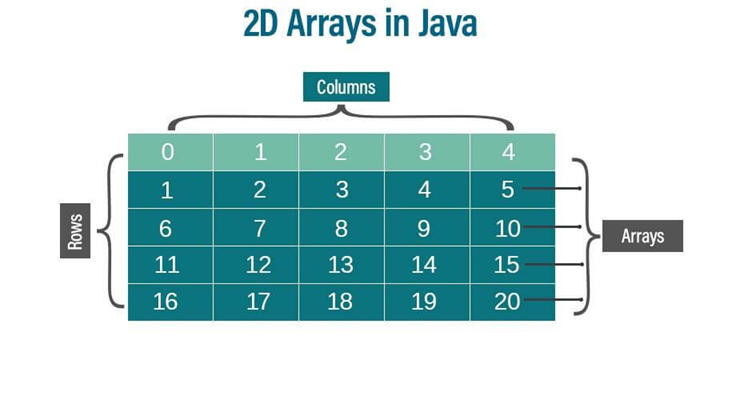
In Java programming, arrays are one of the fundamental data structures that allow you to store multiple values of the same type in an indexed manner. Among various types of arrays, two dimensional arrays are especially useful when dealing with tabular data, matrices, or grid-based problems. This article dives deep into the concept of a two dimensional array in Java, explaining what it is, how to declare and initialize it, and practical examples showcasing its use.
What is a Two Dimensional Array in Java?
A two dimensional array in Java is essentially an array of arrays. Unlike a one dimensional array that stores a single list of elements, a two dimensional array stores data in a matrix form — with rows and columns.
Imagine a spreadsheet where data is arranged in rows and columns; a two dimensional array in Java mimics this structure by allowing access to elements through two indices — one for the row and one for the column.
Visualizing a 2D Array:
luaCopyEdit+---+---+---+
| 1 | 2 | 3 | <-- Row 0
+---+---+---+
| 4 | 5 | 6 | <-- Row 1
+---+---+---+
| 7 | 8 | 9 | <-- Row 2
+---+---+---+
This matrix can be represented in Java as:
javaCopyEditint[][] matrix = {
{1, 2, 3},
{4, 5, 6},
{7, 8, 9}
};
Each element is accessed by specifying its row and column, such as matrix[1][2] which refers to 6 (row 1, column 2).
Declaring Two Dimensional Arrays in Java
The syntax to declare a two dimensional array in Java is:
javaCopyEditdatatype[][] arrayName;
or
javaCopyEditdatatype arrayName[][];
Both are equivalent, but the first one is preferred as it clearly signifies that the variable is a 2D array.
Examples:
javaCopyEditint[][] numbers; // Declaring a 2D array of integers
String[][] names; // Declaring a 2D array of Strings
double[][] grades; // Declaring a 2D array of doubles
Initializing Two Dimensional Arrays
There are several ways to initialize a 2D array in Java.
1. Static Initialization
If you already know the values, you can initialize the array at the time of declaration:
javaCopyEditint[][] matrix = {
{1, 2, 3},
{4, 5, 6},
{7, 8, 9}
};
2. Dynamic Initialization
If you want to declare a 2D array first and fill values later, you specify the size (number of rows and columns):
javaCopyEditint[][] matrix = new int[3][4]; // 3 rows, 4 columns
At this point, all elements in the array are initialized to the default value for int which is 0.
You can then assign values later:
javaCopyEditmatrix[0][0] = 10;
matrix[2][3] = 50;
Key Characteristics of Two Dimensional Arrays in Java
- Rows and Columns: Two dimensional arrays have fixed rows and columns, defined at initialization.
- Zero-based Indexing: Both row and column indices start at 0.
- Rectangular Structure: The number of columns in each row is the same, making it a rectangular grid.
- Jagged Arrays: Java also supports “jagged” or “ragged” arrays, where each row can have a different number of columns (read more at Washington.edu).
Accessing Elements in a Two Dimensional Array
You access elements by specifying both row and column indices:
javaCopyEditint value = matrix[1][2]; // Access the element at 2nd row and 3rd column
You can also modify elements in the same way:
javaCopyEditmatrix[0][1] = 100; // Set the value at 1st row and 2nd column to 100
Iterating Over a Two Dimensional Array
To process all elements, nested loops are used — an outer loop for rows and an inner loop for columns.
Example: Printing a 2D Array
javaCopyEditfor (int i = 0; i < matrix.length; i++) { // loop through rows
for (int j = 0; j < matrix[i].length; j++) { // loop through columns
System.out.print(matrix[i][j] + " ");
}
System.out.println();
}
This code prints the matrix in a row-wise manner.
Jagged Arrays (Arrays of Arrays with Varying Lengths)
Java allows each row of a two dimensional array to have different lengths, which is called a jagged array (see Oracle).
Example:
javaCopyEditint[][] jagged = new int[3][];
jagged[0] = new int[2]; // Row 0 has 2 columns
jagged[1] = new int[4]; // Row 1 has 4 columns
jagged[2] = new int[3]; // Row 2 has 3 columns
You can initialize elements individually, and this flexibility helps when dealing with irregular data.
Common Use Cases for Two Dimensional Arrays in Java
- Matrices in mathematics and graphics
- Game boards (e.g., chess, tic-tac-toe)
- Tabular data representation
- Image processing (pixels as 2D arrays)
- Storing spreadsheet-like data
Examples of Two Dimensional Arrays in Java
Example 1: Simple Matrix Addition
javaCopyEditpublic class MatrixAddition {
public static void main(String[] args) {
int[][] matrixA = {
{1, 2, 3},
{4, 5, 6}
};
int[][] matrixB = {
{7, 8, 9},
{10, 11, 12}
};
int rows = matrixA.length;
int cols = matrixA[0].length;
int[][] sum = new int[rows][cols];
for (int i = 0; i < rows; i++) {
for (int j = 0; j < cols; j++) {
sum[i][j] = matrixA[i][j] + matrixB[i][j];
}
}
System.out.println("Sum of matrices:");
for (int i = 0; i < rows; i++) {
for (int j = 0; j < cols; j++) {
System.out.print(sum[i][j] + " ");
}
System.out.println();
}
}
}
Output:
yamlCopyEditSum of matrices:
8 10 12
14 16 18
Example 2: Transposing a Matrix
Transposing a matrix means converting rows into columns and columns into rows.
javaCopyEditpublic class MatrixTranspose {
public static void main(String[] args) {
int[][] matrix = {
{1, 2, 3},
{4, 5, 6}
};
int rows = matrix.length;
int cols = matrix[0].length;
int[][] transpose = new int[cols][rows]; // flipped dimensions
for (int i = 0; i < rows; i++) {
for (int j = 0; j < cols; j++) {
transpose[j][i] = matrix[i][j];
}
}
System.out.println("Original matrix:");
printMatrix(matrix);
System.out.println("Transposed matrix:");
printMatrix(transpose);
}
private static void printMatrix(int[][] matrix) {
for (int[] row : matrix) {
for (int val : row) {
System.out.print(val + " ");
}
System.out.println();
}
}
}
Example 3: Jagged Array Example
javaCopyEditpublic class JaggedArrayExample {
public static void main(String[] args) {
int[][] jagged = new int[3][];
jagged[0] = new int[]{1, 2};
jagged[1] = new int[]{3, 4, 5};
jagged[2] = new int[]{6, 7, 8, 9};
for (int i = 0; i < jagged.length; i++) {
for (int j = 0; j < jagged[i].length; j++) {
System.out.print(jagged[i][j] + " ");
}
System.out.println();
}
}
}
Output:
CopyEdit1 2
3 4 5
6 7 8 9
Common Pitfalls with Two Dimensional Arrays
- Index Out of Bounds Exceptions: Always check array lengths before accessing.
- Assuming uniform row sizes: Java allows jagged arrays, so length of each row might differ.
- Confusing row and column indices: Remember
array[row][column].
Summary
Two dimensional arrays in Java are a powerful and flexible way to represent tabular data. Whether for mathematical operations, data storage, or grid-based applications, mastering 2D arrays is essential for Java programmers.
- Declared with
datatype[][] arrayName. - Initialized either statically or dynamically.
- Accessed via two indices: row and column.
- Support rectangular and jagged arrays.
- Commonly traversed with nested loops.
- Useful for matrices, game boards, tabular data, and more.
With the examples above, you can confidently start using two dimensional arrays in your Java projects.
Don’t forget to read our Ruby vs Javascript guide.
